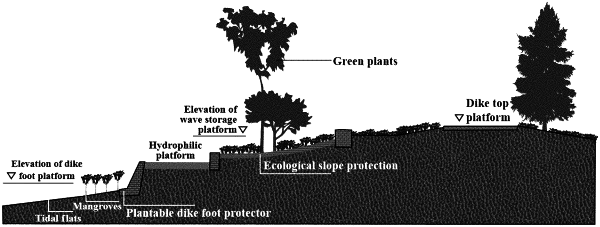| CPC G06F 30/28 (2020.01) [G06F 2111/10 (2020.01); G06F 2113/08 (2020.01)] | 9 Claims |

|
1. A method for analyzing a disaster prevention and mitigation effectiveness of an ecological seawall, comprising:
performing a seawall ecologicalization on a target seawall by using preset vegetations, environment-friendly materials and ecological engineering methods to obtain a target ecological seawall;
establishing three-dimensional space hydrodynamic force for the target ecological seawall by using a preset Navier-Stokes equation and a preset PIMPLE algorithm, wherein the establishing the three-dimensional space hydrodynamic force for the target ecological seawall by using the preset Navier-Stokes equation and the preset PIMPLE algorithm comprises:
obtaining a drag force and an inertia force of a plant population of the target ecological seawall;
filtering the Navier-Stokes equation with a three-dimensional incompressibility according to a preset mass conservation law and a momentum conservation law, the drag force and the inertia force to obtain a control equation, wherein the control equation is:
 wherein ūi represents a volume average velocity, ueff represents a volume average effective viscosity, p represents the volume average dynamic pressure, ρ represents a volume average density, FD,i represents the drag force and Fl,i represents the inertia force, xi represents an i-th horizontal component of a velocity, xj represents a j-th vertical component of the velocity, gi represents a gravitational acceleration of the i-th component, t represents a fluid flow time, ρ{ūi} represents a fluid volume density at an average velocity of a horizontal volume component, ūj represents an average velocity of a volume vertical component, wherein the drag force and the inertia force are used to consider momentum loss caused by the vegetations in this model;
solving the control equation by using the PIMPLE algorithm to obtain a pressure field and a velocity field with a mass conservation;
performing a grid area discretization on the control equation by using a finite volume method to obtain a grid cell area;
setting a boundary condition for the grid cell area, and dividing the grid cell area into a wave-making area and a wave-absorbing area by using the boundary condition; and
establishing the three-dimensional space hydrodynamic force according to the pressure field, the velocity field, the wave-making area and the wave-absorbing area;
carrying out a wave climbing simulation on a dike body and a wave overtopping simulation on a dike top of the target ecological seawall through the three-dimensional space hydrodynamic force to obtain a wave overtopping index;
calculating a wave-flow bottom shear stress of the target ecological seawall by using a preset coastal hydrodynamic model, calculating a bed load sediment transportation volume according to the wave-flow bottom shear stress, and calculating a suspended load sediment transportation volume by using a preset convection-diffusion equation;
mapping the three-dimensional space hydrodynamic force to a two-dimensional bed surface by using a preset finite area method, calculating a two-dimensional bed surface change index according to the suspended load sediment transportation volume and the bed load sediment transportation volume, and determining a development index of tidal flats in front of dike of the target ecological seawall by using a preset Exner equation according to the two-dimensional bed surface change index; and
calculating a disaster prevention and mitigation effectiveness grade of the target ecological seawall according to the wave overtopping index and the development index of the tidal flats in front of dike.
|